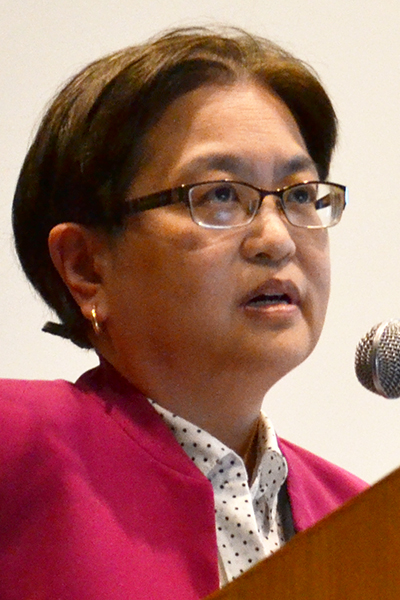To provide the most effective health care, clinicians rely on accurate information about a patient’s personal medical history. However, when a patient is a member of a vulnerable population with unique needs and circumstances, that data can be omitted or obscured.
During the CHEST 2025 session Vulnerable Patient Populations: What Every Provider Should Know on Tuesday, October 21, in Chicago, four clinicians shared lessons about how to optimize the care of patients in vulnerable populations and better understand their full stories.

Unique considerations for veterans
In the United States, military veterans have specific respiratory health concerns often tied to their service and tours of duty, said Laura J. Spece, MD, MSc, Assistant Professor of Medicine and Director of Pulmonary Operations at the University of Washington.
Veterans of the Vietnam War might face complications from exposure to Agent Orange, the toxic herbicide used by US military forces in the war. Veterans who were stationed in the Persian Gulf region are vulnerable to respiratory complications from sandstorms and enormous burn pits used by the military.
Dr. Spece said it is important to document these exposures in the patient history to help patients qualify for federal benefits. She recommended asking specific questions in clinic about any exposure—particularly in relation to contact with burn pits—in order to fully understand patient health risks.
Caring for patients who are transgender

Session Chair Grant Turner MD, MHA, FCCP, urged attendees to create welcoming environments when caring for patients who are transgender. He noted that LGBTQIA+ patients are more likely to have faced discrimination within a health care system and are generally more reluctant to discuss personal issues with clinicians.
“When these patients are coming to you, they may be holding back on asking questions because they are worried about what the answers may be and are feeling less comfortable than they should,” said Dr. Turner, Asssistant Professor of Medicine and Associate Director of the UCLA Adult Cystic Fibrosis Center.
In working with patients who are transgender, clinicians should be aware of and discuss unique factors that might impact the patient’s health, Dr. Turner said. For example, pulmonary function testing results might be skewed depending on whether a patient is evaluated within the framework of their gender or within the framework of their sex assigned at birth. Chest wall bindings—a gender-affirming practice for many transgender men—can also affect these tests. Additionally, hormone treatments should be considered as a factor in OSA. When starting testosterone, clinicians and patients should consider OSA risk; when starting estrogen in a patient with OSA, clinicians and patients should consider rescreening.

Language barriers in the clinic
Cindy Hou, DO, addressed possible language barriers among immigrant patient populations. Dr. Hou, Medical Director of Research at Jefferson Health, noted that language fluency is often on a scale. While it can be easy to identify patients who are not fluent in the clinic’s default language, it is also essential to identify limited language proficiency or cases when even a fluent speaker might not be familiar with medical terms. Talking directly with a patient about whether they wish or need an interpreter as close to the beginning of treatment as possible can avoid complications, she said.
“When somebody first comes in, it is so important that the person who does the registration and takes insurance information also documents preferred primary language—that is critical,” Dr. Hou said.
Pediatric-to-adult pulmonary care transition

Alicia Mirza, MD, Clinical Assistant Professor and Director of Pediatric to Adult Pulmonary Transitions at Stanford University, spoke about the challenges faced by young patients with special pulmonary care needs when they transition from pediatric to adult care.
Studies have shown poor health outcomes for patients in the period after this transition, including a decline in FEV for young adults with cystic fibrosis and a decline in health-related quality of life for young adults with asthma, Dr. Mirza explained.
She noted that the young adult age period presents inherent health challenges, such as increased risk of violence, housing instability, and unemployment. When pediatric patients shift to adult care, additional issues may include loss of longstanding relationships with pediatric care teams, new issues with care access or insurance, and different or conflicting expectations. Specialized, cross-department transition programs can help to reduce these barriers, promote equitable care, and empower patients into early adulthood and beyond, Dr. Mirza said.
The panel noted that there are many vulnerable patient groups, and some patients might fall into more than one category. Understanding all identities that contribute to a patient’s medical history and needs begins by asking questions and listening to answers.
“When we don’t have all the data, asking the person in front of you is one of the greatest tools, and it also allows for a level of human connection, which is so important for human care,” Dr. Mirza said.
“I think we are always afraid it will take too much time,” Dr. Spece added. “But taking time to ask questions and to listen can actually be more efficient because you avoid crossing wires or missing a patient’s story.”

Call for Topics Is Open
Feeling inspired by all the great sessions in Chicago? Help shape the curriculum for CHEST 2026, October 18 to 21 in Phoenix, by submitting topic ideas from areas you’re passionate about, topics affecting your practice, or new technologies you’d like to learn more about. The submission deadline is Tuesday, December 2, at 2 pm CT.


